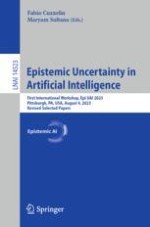2024 | Buch
Epistemic Uncertainty in Artificial Intelligence
First International Workshop, Epi UAI 2023, Pittsburgh, PA, USA, August 4, 2023, Revised Selected Papers
herausgegeben von: Fabio Cuzzolin, Maryam Sultana
Verlag: Springer Nature Switzerland
Buchreihe : Lecture Notes in Computer Science
